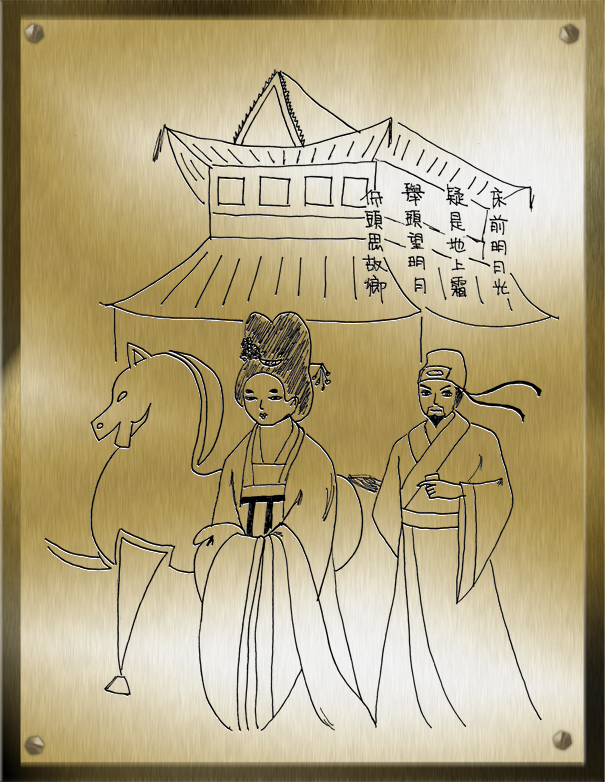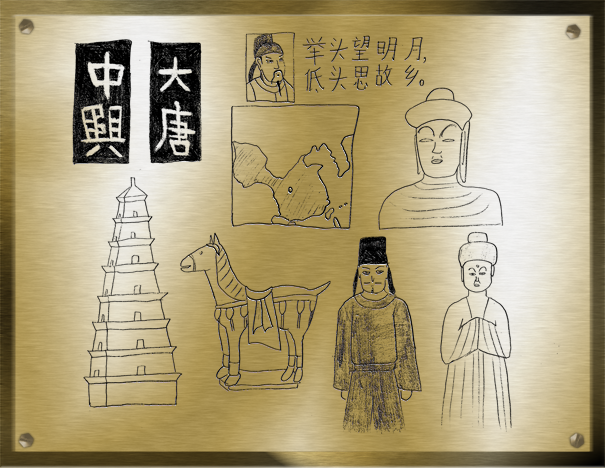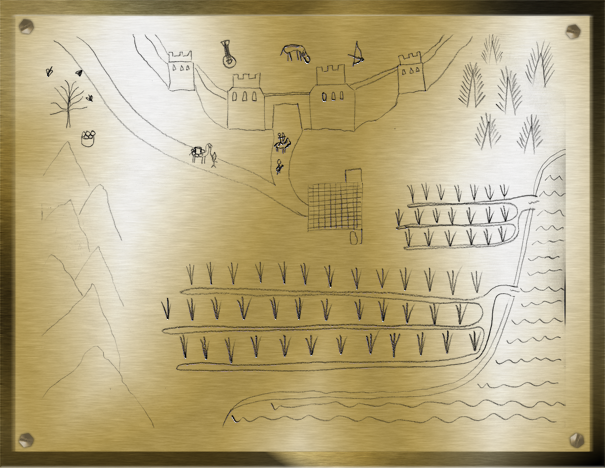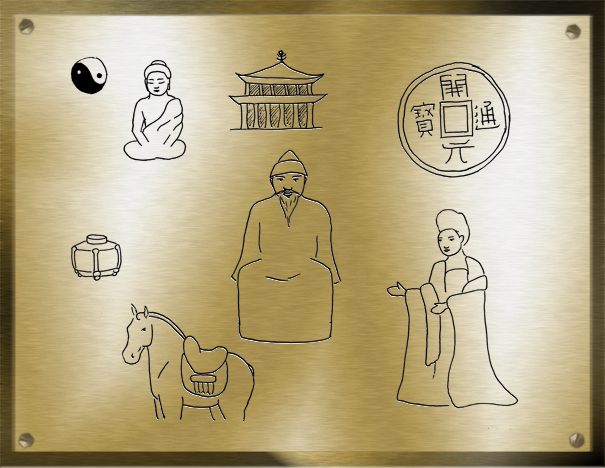| Time Period | Tang Dynasty |
| Geographical Region | In the capital of Tang Dynasty, Changan |
| List of Symbols |
|
I set the time of this plaque at the time of Tang Dynasty, roughly during the time of high Tang, between the reign of Li Shimin, Tang Taizong, and Li Longji, Tang Xuanzong. Tang Dynasty is probably the most flourished time in Chinese history. From my perspective, Tang is famous for its Turkic ancestry, its exuberant culture, and its openness. The founder of Tang Dynasty has Turkic ancestors, so many aspects in Tang, like its clothing, has Turkic characters. For Tang’s exuberant culture, thousands of beautiful poems were written in Tang. For its openness, the capital Chang’an was like an international city, people from different places all came and gathered here. Those things are some characters of Tang I reckoned as important. Therefore, in my plaque, I tried to use pictures to convey the ideas I talked above.
The man and the woman in the front represented typical people in Tang time. The woman dressed in a loose dress, which completely hide her waist. However, we could still see her rounded figure under the dress. Unlike in other dynasties like Song or Qing, or even now, Tang is a time when full figure was seen as a sign of beauty. This is probably because of Tang Xuanzong’s Precious Consort, Yang Yuhuan. She is famous for her curvy body. Since she is much appreciated and loved by the Emperor, her rounded figure was also what women at that time aspired to. Another detail is the part of her breasts. The neckline of the dress is rather low, compared to the dresses for women in other dynasties. This is a suggestion of the openness of Tang, and also a suggestion that the freeness women enjoy at that time is more than probably any dynasties in Chinese history. In Tang Dynasty, women had many head accessories to wear. In Bai Juyi’s poem Pipa Xing, and Changhen Ge, he described the accessories women wore at that time, which were very much like the accessories the woman in the plaque is wearing. For example, Bai Juyi mentioned “bu yao” and “sao tou”. These are the kind of head accessory women wore in Tang in order to stable their bun. The thing that is on the right side of the woman’s hair is a roughly pictured “bu yao”. The man is also wearing typical Tang clothes. The hat he is wearing is especially typical in Tang, since no other dynasties had the similar kind of hats for men. The male clothes in Tang have strong characters of Turkic origins, since the founder of Tang has Turkic ancestors.
The picture behind the two people shows a horse. This picture is trying to convey a sense of wall painting in the time of Tang and to show the Turkic origin of Tang. The founder of Tang Dynasty, Li Yuan, like the Sui emperors, belonged to the north Chinese aristocracy and was of mixed Chinese and Turkic ancestry. Therefore, Tang Dynasty had more Turkic characters than other dynasties had. Because of their Turkic ancestry, they were more used to horse riding. This is also why here is a horse. The horse is used to show the popular of horse riding in Tang. In fact, not only men, women in Tang Dynasty also rode out together with male members for hunting constantly.
In the background, there is a poem, called “Jing Ye Si”. This poem was written by Li Bai, a renowned Tang poet. Poetry was very popular during the Tang Dynasty, and it was even used in the national examinations at that time. There were many different poem structures in Tang. However, all those different structures of Tang poetry, unlike “ci” in Song, were all very much in order. Each sentence is always required to have certain amount of characters. I chose this poem because this poem fits into the structure perfectly and can give people a rough sense of what a Tang poem looks like. The structure of this poem in the background is called “wu jue”. “wu” means five, because it has five characters in each sentence.
The building in the background shows a typical building of the Tang time. The building technology in Tang developed greatly due to the flourished economic development it enjoyed. In addition, because of its openness, buildings in Tang also tended to be grand. The buildings usually had many beautiful decorations on them. The buildings in Tang were also known for their wood structure. This is a special building technique very much different from the building techniques people in west used. People still used it in China even until Qing Dynasty. Even though there were not much buildings in Tang left in China now, I still chose to include a building here in my plaque because the building at that time was very beautiful, and was of significance importance to the buildings in later dynasties, and even to the buildings in Japan.
It is very hard to completely show Tang Dynasty in just one plaque. Tang definitely is something much bigger than what is shown here on this plaque. However, I still hope that this plaque will give people some idea of Tang, and let people know what greatness China once enjoyed in the time of the Tang.

RUTIAN WANG is a junior at University of Rochester. Rutian Wang is from Beijing, China. She is an English major and in her spare times enjoys watching movies and reading books. More by Rutian




 JACQUELINE HEINZELMANN is a student at the University of Rochester. Jacqueline, who goes by Jackie, studies International Relations and East Asian Studies. When she is not busy writing essays for her various classes, she is probably reading.
JACQUELINE HEINZELMANN is a student at the University of Rochester. Jacqueline, who goes by Jackie, studies International Relations and East Asian Studies. When she is not busy writing essays for her various classes, she is probably reading. 
 ELIZABETH SCHEUERMAN is a History, English, and Art History major at the University of Rochester. She works at UR’s Department of Rare Books & Special Collections, and hopes to pursue a career in Museum Studies. In her free time, Elizabeth enjoys foreign films and reading.
ELIZABETH SCHEUERMAN is a History, English, and Art History major at the University of Rochester. She works at UR’s Department of Rare Books & Special Collections, and hopes to pursue a career in Museum Studies. In her free time, Elizabeth enjoys foreign films and reading.